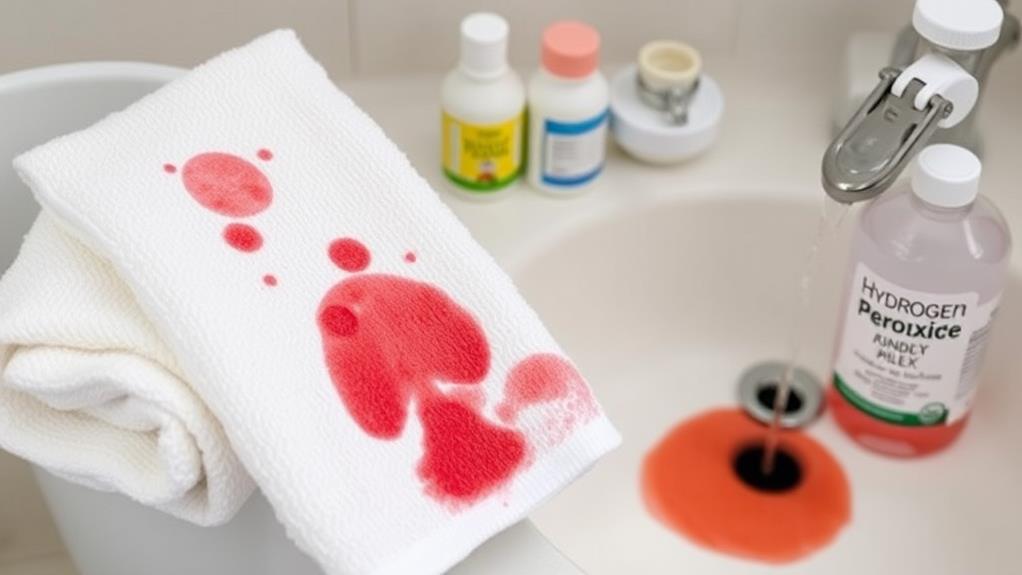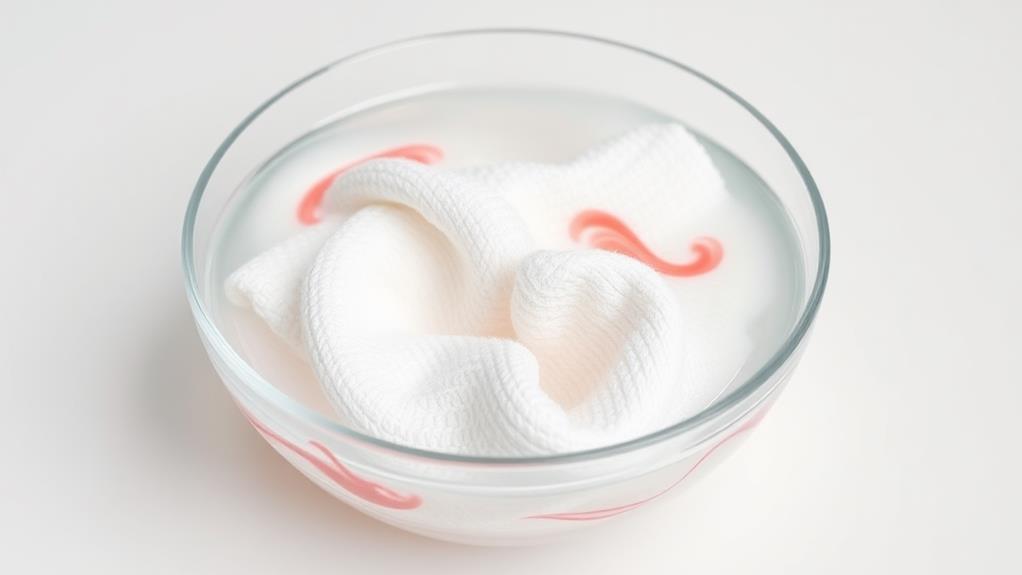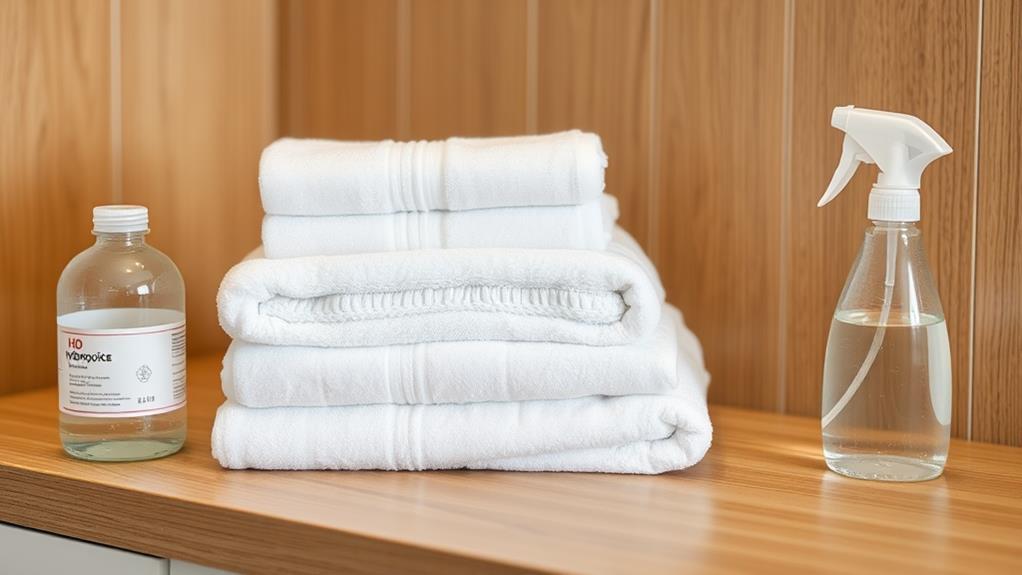How to Get Blood Out of Towels
To remove blood from towels, act quickly. Rinse the stain with cold water immediately, then blot gently with a clean cloth. Avoid hot water, which can set the stain. Apply a stain removal solution like hydrogen peroxide mixed with baking soda, or use a specialized product like Remüvie. For stubborn stains, try salt mixed with cold water. Wash the towel in cold water with mild detergent on a gentle cycle. Inspect before drying, and use low heat or air-dry to prevent setting any remaining stain. Remember, time is critical; the sooner you address the stain, the better your chances of complete removal. Further exploration of these techniques can lead to even more effective stain-fighting strategies.
This post may contain affiliate links. If you make a purchase through these links, I may earn a commission at no additional cost to you. Additionally, portions of this post may be generated using artificial intelligence (AI) technology. While we strive for accuracy, please be aware that AI-generated content may not always be perfect and should be fact-checked when necessary.
The Spatula Scoops
- Rinse the blood-stained area immediately with cold water to prevent coagulation and setting.
- Apply a paste of hydrogen peroxide and baking soda directly to the stain, gently blotting with a clean cloth.
- Use specialized stain removers like Remūvie for stubborn blood stains on towels.
- Wash towels in cold water with mild detergent on a gentle cycle to protect fabric fibers.
- Inspect towels after washing and dry on low heat or air dry to prevent setting any remaining stains.
Act Quickly for Fresh Stains

When dealing with fresh blood stains on towels, time is of the essence. You'll want to act quickly to prevent the stain from setting into the fabric, which can make it much harder to remove later. Start by rinsing the affected area with cold water immediately. It's vital to use cold water, not hot, as hot water can cause the blood proteins to coagulate, making the stain more stubborn.
Before rinsing, blot the stain gently with a clean cloth or paper towel. This helps absorb excess blood and prevents it from spreading. Replace the towel as needed to avoid redepositing blood onto clean areas. After blotting, rinse with cold water thoroughly.
If you have dishwashing liquid on hand, apply a small amount directly to the stain. Let it sit for 15-30 minutes to break down the blood particles. This step can greatly improve your chances of removing the stain completely. Remember, immediate action is key. The longer you wait, the more likely the stain will become permanent. By following these steps promptly, you'll maximize your chances of successfully removing fresh blood stains from your towels.
Gather Necessary Cleaning Supplies
Before tackling blood stains on towels, it's critical to gather all the necessary cleaning supplies. Start by collecting the blood-stained towels, ensuring you focus on the affected areas. The most significant item you'll need is hydrogen peroxide, a powerful cleaning agent that's particularly effective on light-colored fabrics. Don't forget to grab some baking soda as well; when combined with hydrogen peroxide, it creates a potent paste that helps loosen stubborn stains.
You'll also need a clean cloth for blotting and rinsing, which is essential to prevent the stain from spreading during the cleaning process. For enhanced stain removal effectiveness, consider using a specialized stain remover like Remüvie Intimate Stain Remover as a pre-treatment option. This can help break down the blood proteins before you begin the main cleaning process.
Cold Water Rinse Technique

The cold water rinse technique is your essential first step in removing blood stains from towels. You'll want to act quickly, as fresh stains are easier to remove. Start by running cold water over the stained area immediately. This helps prevent the blood from setting permanently into the fabric fibers.
As you rinse, use a gentle squeezing motion to work the water through the towel. Avoid rubbing vigorously, as this can damage the fabric and spread the stain. Aim to rinse for at least 5-10 minutes, ensuring the blood runs out rather than deeper into the fibers. To maximize effectiveness, place a clean cloth or paper towel behind the stained area while rinsing. This will absorb the blood as it's loosened from the fabric. Replace the absorbent material as needed.
It's essential to use cold water throughout this process. Hot water can cause blood proteins to bond with the fabric, making the stain more challenging to remove. By using cold water, you're giving yourself the best chance of successfully removing the blood stain from your towel.
Applying Stain Removal Solutions
Having rinsed the blood-stained towel with cold water, it's time to apply targeted stain removal solutions. You've got several options to choose from, depending on the severity of the stain.
For a natural approach, try using a mixture of hydrogen peroxide and baking soda. Create a thick paste, apply it to the blood stains, and let it sit for 30 minutes. Then, blot with a clean cloth to check if the stain's lifting. If you're dealing with extremely stubborn stains, consider using Remūvie Stain Remover. Apply the foam directly to the stain, wait 20 seconds, and dab with a damp cloth.
Another effective method is to make a paste using coarse salt and cold water. Spread it generously over the stained area, gently scrub with a soft brush, and rinse with cold water. For a simpler solution, you can try using mild detergent. Apply it directly to the stain, let it sit for 15-30 minutes, then rinse and wash the towel on a gentle cycle.
Remember to always test new cleaning solutions on a small, inconspicuous area first. If the stain persists, repeat the process or try a different method.
Washing and Drying Methods

Proper washing and drying are essential steps in successfully removing blood stains from towels. When you're ready to wash blood-stained towels, use cold water and a mild detergent. Set your washing machine to a gentle cycle to effectively remove stains without causing damage to the fabric fibers. It's vital to avoid bleach or harsh chemicals during this process, as they can irreparably harm the towels and may not effectively eliminate the stain.
After the wash cycle is complete, inspect your towels carefully. Make sure the stain is completely gone before proceeding to dry them. If you notice any remaining traces of blood, rewash the towels, as heat can set stubborn stains into the fabric. When it comes to drying, opt for low heat settings in your tumble dryer or consider air drying to prevent any potential heat-related stain setting. Remember, regular laundering of your towels can prevent the buildup of tough stains, making them easier to clean in the future. By following these washing and drying methods, you'll increase your chances of successfully removing blood stains from your towels.
Frequently Asked Questions
How to Remove Dried Blood From a Towel?
To remove dried blood from a towel, start by soaking it in cold, salted water for several hours. Then, create a baking soda paste and apply it to the stain for 30 minutes. You can also use an enzyme-based stain remover or Remüvie Intimate Stain Remover for 15-20 minutes. If the towel's light-colored, try hydrogen peroxide for 30 minutes. After pre-treating, machine wash the towel on a gentle cycle with cold water and mild detergent. Always check if the stain's gone before drying.
Will Period Blood Come Out of a Towel?
Yes, period blood can come out of a towel. You'll have the best results if you act quickly. Rinse the towel in cold water immediately to flush out as much blood as possible. Then, apply a mixture of cold water and dishwashing liquid or hydrogen peroxide directly to the stain. For tough stains, use an enzyme-based stain remover designed for protein stains. After treating, wash the towel as usual and dry it in sunlight if possible to aid in natural bleaching.
Does Vinegar Get Blood Out of Towels?
Yes, vinegar can be effective in removing blood from towels. You'll want to mix equal parts white vinegar and cold water, then soak the stained area for about 30 minutes. For tougher stains, apply undiluted vinegar directly to the blood spot. Let it sit for 10-15 minutes before blotting and rinsing. Remember to test the vinegar on a small, hidden area first to avoid potential damage. It's most effective on fresh stains, so act quickly for best results.
Is Hot or Cold Water Better for Blood Stains?
Cold water is definitely better for blood stains. You'll want to use cold water immediately to rinse the stain, as it helps loosen the blood and prevent it from setting deeper into the fabric. Hot water, on the other hand, can cause the blood proteins to coagulate, making the stain permanent. Always start with cold water for rinsing and soaking blood-stained items. Only switch to hot water after you've completely removed the stain to guarantee thorough cleaning.





